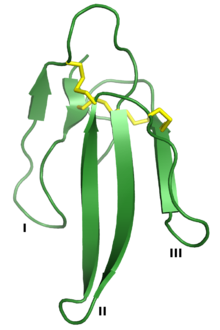| Three-finger protein | |
|---|---|
 Erabutoxin A, a neurotoxin that is a member of the three-finger toxin superfamily. The three "fingers" are labeled I, II, and III, and the four conserved disulfide bonds are shown in yellow. Rendered from PDB: 1QKD.[1] | |
| Identifiers | |
| Symbol | ? |
| CATH | 1qkd |
| SCOP2 | 1qkd / SCOPe / SUPFAM |
Three-finger proteins or three-finger protein domains (3FP or TFPD) are a protein superfamily consisting of small, roughly 60-80 amino acid residue protein domains with a common tertiary structure: three beta strand loops extended from a hydrophobic core stabilized by disulfide bonds. The family is named for the outstretched "fingers" of the three loops. Members of the family have no enzymatic activity, but are capable of forming protein-protein interactions with high specificity and affinity. The founding members of the family, also the best characterized by structure, are the three-finger toxins found in snake venom, which have a variety of pharmacological effects, most typically by disruption of cholinergic signaling. The family is also represented in non-toxic proteins, which have a wide taxonomic distribution; 3FP domains occur in the extracellular domains of some cell-surface receptors as well as in GPI-anchored and secreted globular proteins, usually involved in signaling.[2][3][4][5]
- ^ Nastopoulos V, Kanellopoulos PN, Tsernoglou D (September 1998). "Structure of dimeric and monomeric erabutoxin a refined at 1.5 A resolution" (PDF). Acta Crystallographica. Section D, Biological Crystallography. 54 (Pt 5): 964–74. Bibcode:1998AcCrD..54..964N. doi:10.1107/S0907444998005125. PMID 9757111.
- ^ Kini RM, Doley R (November 2010). "Structure, function and evolution of three-finger toxins: mini proteins with multiple targets". Toxicon. 56 (6): 855–67. doi:10.1016/j.toxicon.2010.07.010. PMID 20670641.
- ^ Hegde RP, Rajagopalan N, Doley R, Kini M (2010). "Snake venom three-finger toxins". In Mackessy SP (ed.). Handbook of venoms and toxins of reptiles. Boca Raton: CRC Press. pp. 287–302. ISBN 9781420008661.
- ^ Kessler P, Marchot P, Silva M, Servent D (August 2017). "The three-finger toxin fold: a multifunctional structural scaffold able to modulate cholinergic functions". Journal of Neurochemistry. 142 (Suppl 2): 7–18. doi:10.1111/jnc.13975. PMID 28326549.
- ^ Utkin Y, Sunagar K, Jackson TN, Reeks T, Fry BG (2015). "Chapter 8: Three-finger toxins". In Fry B (ed.). Venomous Reptiles and Their Toxins: Evolution, Pathophysiology and Biodiscovery. Oxford University Press. pp. 218–227. ISBN 9780199309405.